It’s easy to boost your gut health when ferments taste this good! Here are 50+ probiotic and lacto-fermented drinks beyond Kombucha and kefir, including ginger soda, pineapple kanji, mead, and more.
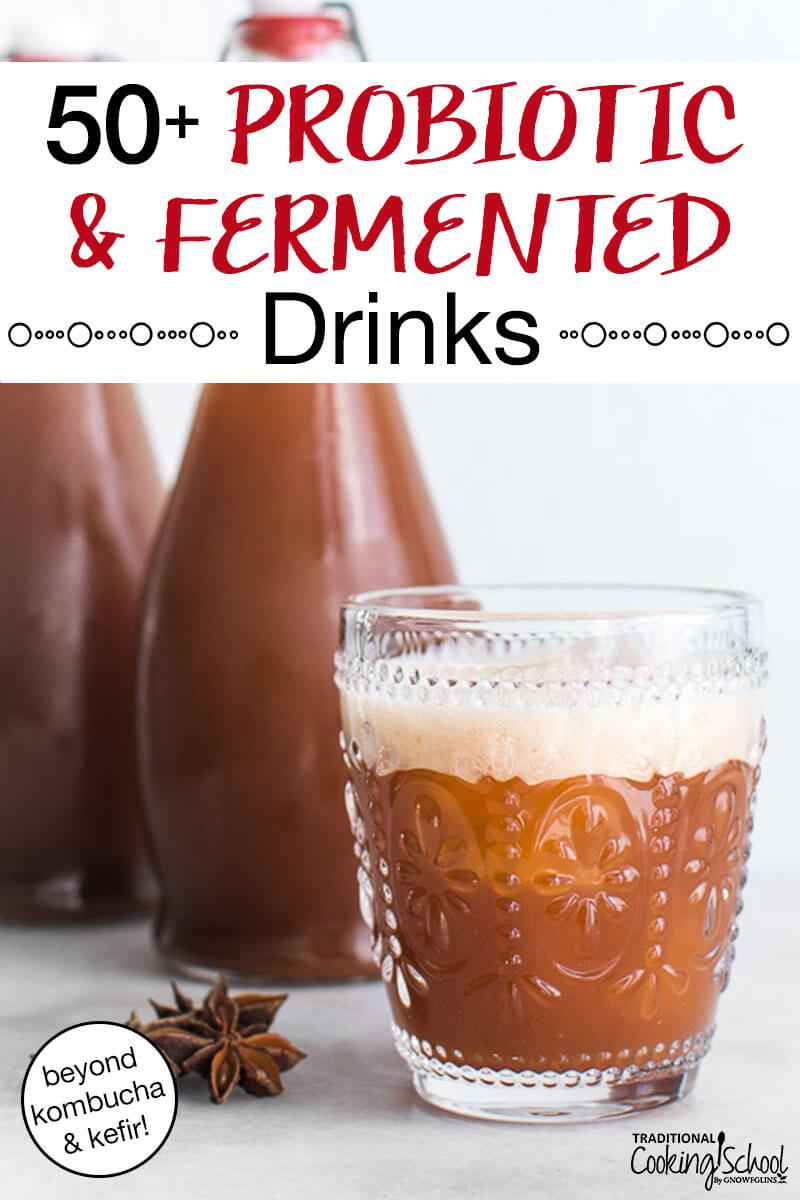
I have one last trick up my sleeve…
If you won’t eat your probiotics, surely you’ll DRINK them!
In case you can’t tell, I have made it my mission in life to help you find fermented foods you and your family actually want to eat.
And this is the biggest fermented round-up yet.
On a personal note, it was also the most fun for me. I mean, who knew there were so many variations of kvass?!
One thing you’ll notice is that I haven’t included Kombucha or dairy kefir (except in smoothies) or water kefir. Although those beverages are super yummy and super good for you, they’re also very common.
And… the greater the variety of fermented foods you include in your diet, the more strains of beneficial bacteria and yeast (a.k.a. probiotics) your gut receives.
Different Bacteria & Yeast Strains In Fermented Drinks
Why do people drink Kombucha? What is the difference between kefir and Kombucha?
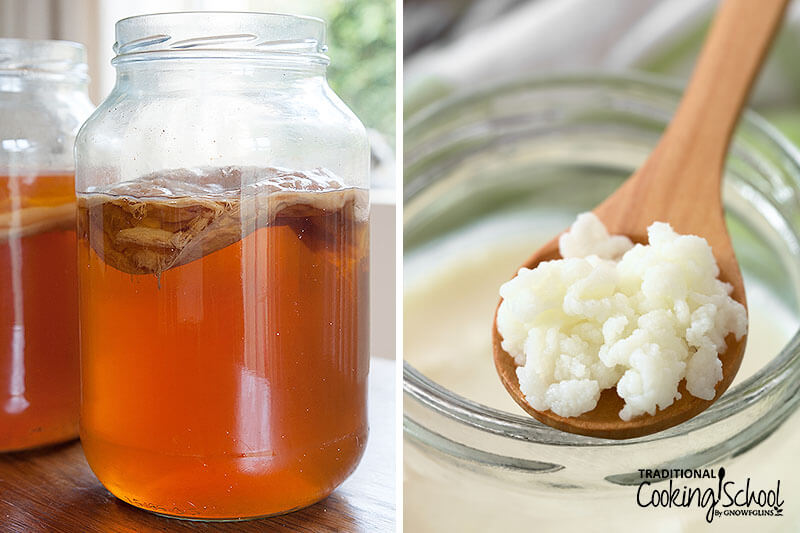
Kombucha contains a few strains of bacteria (Acetobacter and Gluconacetobacter are the most common) and a few strains of yeast too, like Saccharomyces boulardii and Zygosaccharomyces kombuchaensis — a strain unique to Kombucha (source).
Milk kefir contains many more strains of bacteria (Lactobacillus, Leuconostoc, and Acetobacter to name a few) and yeast (Candida, Kluyveromyces, and Saccharomyces; source).
Bacterial strains such as Lactobacillus acidophilus and bulgaricus and Bifidobacterium bifidus occur in whey, so any ferment made with whey as a starter will contain them.
While still helpful for gut health, the bacteria and yeast strains will be vastly different when using a veggie starter culture (lactobacillus plantarum and Ped. acidilactici; source).
Furthermore, “wild ferments” gather any good bacteria and yeasts naturally in the air or on the skin of whatever fruit or veggie you’re fermenting without an additional starter culture. Who knows what beneficial strains are present then!
So if you’re only drinking Kombucha or kefir as your sources of fermented beverages, you’re denying your body the thousands of other helpful, healing strains that occur in kvass or cultured cider, for example.
It all boils down to this: your body benefits from ALL of them!
More variety of fermented foods = more variety of probiotics = happier tummy and health benefits overall. 🙂
How To Eat A Variety Of Fermented Foods
Am I saying you have to make all the fermented foods out there in order to achieve glowing health? No.
I am saying that you should try to incorporate as much variety with your ferments as you do with the other foods you eat.
Eating the same thing over and over gets boring and deprives your body of the joy and health that comes from eating many foods in all colors of the rainbow. The same is true with ferments.
The beautiful thing about fermenting is that it really ebbs and flows with the changing of the seasons.
In the fall when apples are in abundance, make some spontaneously fermented apple cider. Fall is also the perfect time for some fermented pumpkin butter.
During the summer when veggie harvest is at its peak, make pickles, lacto-fermented green beans, and salsas. Summer is the perfect time to flavor your Kombucha with blueberries or make a fruit kvass.
With the blooming of the flowers in spring, try some elderflower or rose hip soda or any of these springtime ferments.
You can even try specific ferments, like this fermented turmeric tonic or fire cider, to boost your immune system or help fight off illness.
If it’s raw milk and wild fermentation you love, try Bonny Clabber Panna Cotta year round.
Just don’t be afraid to experiment until you find several you love! And in my opinion, fermented drinks are a delicious place to start!
Are all fermented drinks alcoholic?
Most lightly fermented drinks — like water kefir, natural soda, or Jun — contain very little alcohol, anywhere from 0.5% to 2% alcohol.
Drinks like mead and wine are brewed specifically for their alcohol content (as well as their flavor). The alcohol content in these fermented drinks ranges from about 3.5% to over 20%.
Natural Sodas
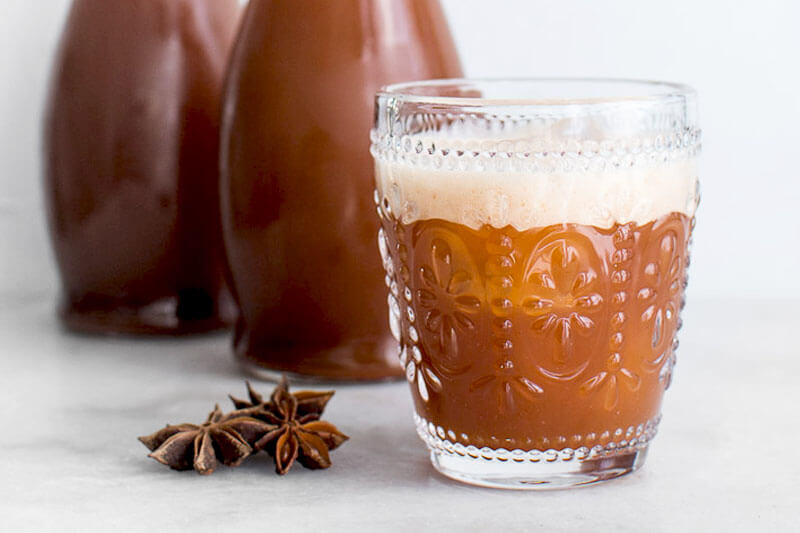
Image courtesy of Nourished Kitchen.
To make fermented soda, we use whey or a ginger bug as the starter. Combined with fruit juice or herbal tea, the ferment is easy and produces a traditionally fermented beverage.
Enjoy the following collection of fruit or herb-based sodas.
Non-Alcoholic “Beers” (Ginger Beer & Root Beer)
Old-Fashioned Root Beer — A simple fermented root beer teeming with gut-healing action and old-fashioned root beer flavor!
Homemade Ginger Beer — Learn how to make a ginger bug first… and then on to this spicy, probiotic treat.
Honey-Sweetened Ginger Beer — Perfect for those on the GAPS Diet, this bubbly fermented soda is sweetened with honey instead of sugar!
Homemade Root Beer — There’s an undeniable charm to mixing roots, twigs, herbs, and berries together for homemade root beer.
More Fruit & Herb Sodas!
Peaches & Cream Soda — The summer flavor of peaches combined with whey makes this refreshing beverage.
Sweet Potato Fly — Want your kids begging for more probiotic drinks? Then make this slightly effervescent and aromatic sweet potato fly!
Fizzy Dandelion Soda — Send the kids out with a big bowl, and let them gather all the dandelion blooms they can find. Then make this fizzy soda! Weed control and gut health… who could ask for more?
Elderflower Soda — Just as being in nature and gathering elderflowers is healing for the spirit, using those elderflowers in a fermented soda is healing for the body. Double win!
Naturally Fermented Pineapple and Ginger Soda — With just three ingredients, you can enjoy soda again!
Fermented Rose Hip Soda — This low-maintenance fermented soda uses whole rose hips, high in Vitamin C and fantastic for the immune system.
Fermented Elderberry and Honey Soda — Keep this family-friendly soda on hand during cold and flu season since both elderberries and honey are powerful anti-virals!
Watermelon Soda — The amazing flavor of watermelon is magnified when fermented into soda.
Fermented Blackberry Soda — Have any foraged berries in your freezer that aren’t very sweet? Use them to flavor a fermented soda!
Grape Drink — This is a step-by-step photo tutorial of Nourishing Traditions’ Grape Drink!
Apple-Pomegranate Soda — Fizzy, sweet, refreshing, and all natural… this is what soda is supposed to be!
Fermented Grapefruit Juice — Perfectly tart and fresh, fermented grapefruit juice is amazing on its own.
Orangeina — Try this healthy orange soda that’s full of flavor and probiotics!
Probiotic Lemonade — Who doesn’t like lemonade?! Here’s a recipe that’s easy on the wallet and the tummy.
Probiotic Ciders & Other Juices
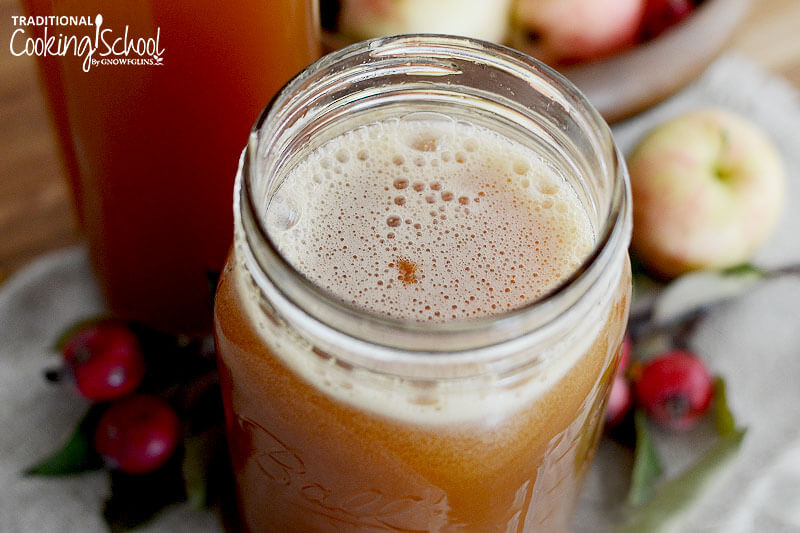
Ciders are usually made with just one ingredient — apples!
A kind of wild ferment, apple cider is charged by the microscopic yeasts and bacteria already found on apple skin! These beneficial organisms feed off the naturally occurring sugars found in the apples’ juice.
Spontaneously Fermented Sparkling Apple Cider — Fall’s easiest ferment is so easy it can hardly be called a recipe. After all, it’s just 1 ingredient: freshly pressed apple cider!
Simple Apple Peel Cider — Feeling a teeny bit guilty about all those apple peels in your compost? No more! Just turn them into cider!
Spontaneous Hard Apple Cider — This recipe literally calls for one ingredient: unpasteurized apple cider. Nature does the rest and makes it good for your belly!
Naturally Fermented Kvass
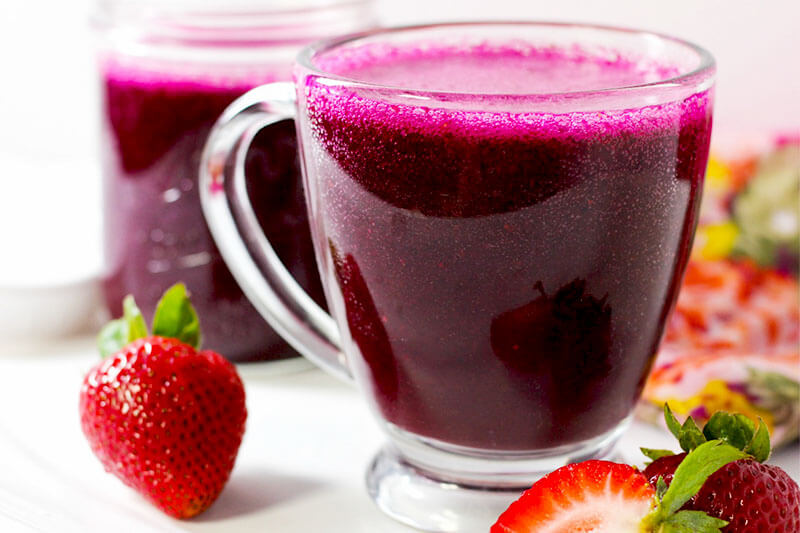
Image courtesy of Eat Beautiful.
Kvass, originally created in Ukraine over 1,000 years ago, is made from stale bread or beets plus many other additional (and historical) flavorings.
Usually inoculated with either sauerkraut juice or whey (or made with wild fermentation techniques), it is rich in potassium and antioxidants, very easy to make, and simply delicious.
Beet Kvass — According to Nourishing Traditions, beet kvass is “an excellent blood tonic, promotes regularity, aids in digestion, alkalizes the blood, cleanses the liver, and is a good treatment for kidney stones and other ailments”. Wow!
Whey-Free Beet Kvass — Enjoy beet kvass without whey, if you find that flavor unpleasant or are dairy-free.
Sweet Raspberry Beet Kvass with Lovely Variations — Variations include hibiscus, lavender and ginger. Delicious and so refreshing!
Black Raspberry Kvass — Fruit-based kvasses are a wonderful way to get kids to enjoy this healing drink. Black raspberry sounds like a pretty darn good flavor for grown-ups too!
Strawberry-Beet Kvass — Full of beneficial electrolytes and sodium, this kvass is great for kids, more like a super healthy probiotic smoothie!
Lacto-Fermented Fruit Kvass — If you’ve been dreaming of putting probiotic goodness into your body, this basic recipe is a good place to start.
Beet Kvass That Actually Tastes Good — This savory beet kvass is made with cabbage and onions!
Orange-Ginger-Carrot Kvass — Full of immune boosting properties, this kvass is orange-colored: no beets in sight!
Mead & Wine
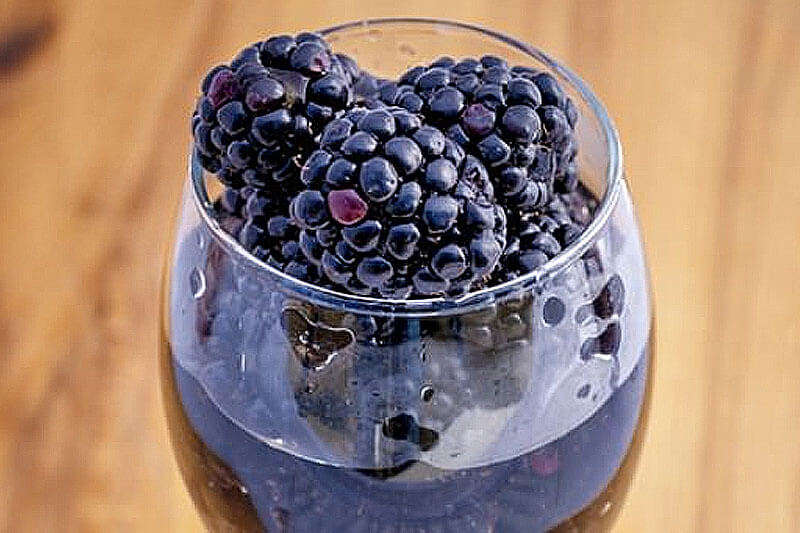
Image courtesy of Hobby Farms.
Mead, an ancient fermented honey-drink, traces its origins back to Europe, Africa, and Asia. It is alcoholic and may be made from simply water and honey, or often fruits, spices, grains, and hops are included.
Wine, an alcoholic fermented beverage, typically uses grapes. Yeast consumes the sugars in grapes to produce alcohol.
Different strains of yeasts and different fruits produce a variety of wines. Enjoy these mead and wine recipes!
Easy Natural Mead — Basically “honey wine”, mead aids digestion and pairs well with everything from roasted meat to pecan pie.
Blueberry Orange Mead — Made with honey and yeast, this recipe yields a gallon of mead.
Elderberry Wine — With a sun-extracted version, the author of this recipe says Elderberry Wine is, “… rich, sweet and fruity… To me it smells like abundance. If I have enough fruit to ferment, then it’s been a bountiful year.”
Easy Blackberry Wine — Use wild blackberries, honey, lemon juice and a small amount of black tea to make this special summer beverage.
Kefir & Yogurt Smoothies, Plus Lassis
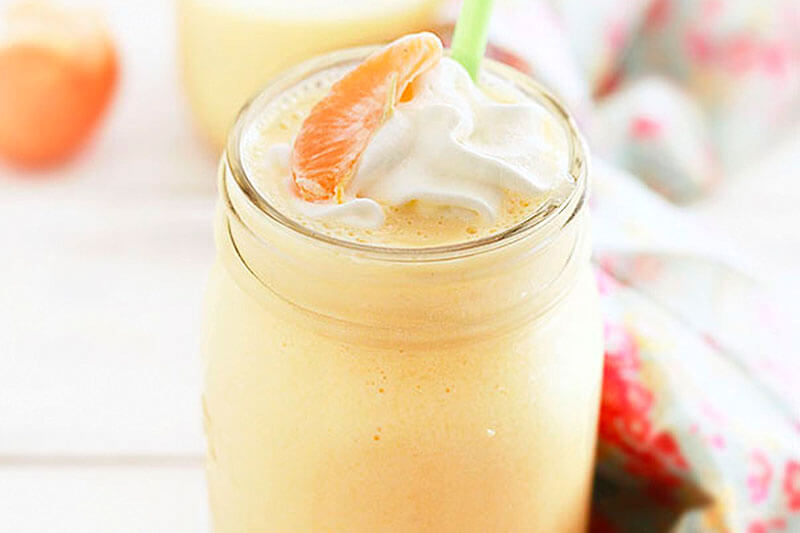
Image courtesy of Yummy Mummy Kitchen.
The naturally occurring sugar (lactose) found in milk is great food for beneficial bacteria. Kefir and yogurt contain different strains of probiotics which proliferate when able to consume lactose.
The following recipes use probiotic yogurt or kefir in smoothies — for healthy treats.
Tropical Probiotic Smoothie — A nutrient-dense smoothie that combines health and yumminess with the addition of water kefir or Kombucha.
PowerHouse Kefir Smoothie — You’ll love how many powerhouse ingredients are in this smoothie.
Honey Spice Lassi — This would be a wonderful drink to serve on a holiday morning to get the festivities started the right way! It’s also a great breakfast for kids and adults before busy family activities begin each day!
Apple Pie Smoothie — This recipe uses a mildly flavored Piima yogurt for those of you who don’t enjoy a too-tart-and-tangy fermented flavor.
Orange Protein Smoothie — Do you like orange creamsicles? Then you’ll LOVE its healthier cousin!
Super Easy Strawberry Kefir Smoothie — Now here’s a great way to start the day!
Frozen Summer Fruit Kefir Smoothie — Maybe your family doesn’t care for kefir yet. Give this smoothie a try, and see if it doesn’t make them converts!
Turmeric Lassi — Lemon, ginger, turmeric, raw honey, AND kefir?! I’m not sure I can come up with a more healing drink than that!
Mint Lassi — Crisp and refreshing mint comes together with kefir to create a truly digestible treat!
Chocolate Kefir Smoothie — A tasty chocolate dessert that’s packed with all the benefits of kefir!
Probiotic Switchels
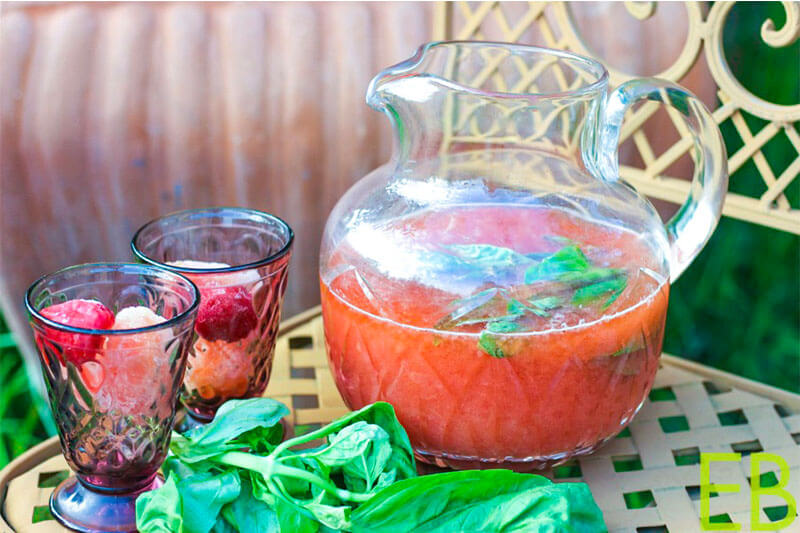
Image courtesy of Eat Beautiful.
Apple cider vinegar contains probiotics and inoculates this simple ferment. Incredibly hydrating and refreshing, you can make and consume switchels the same day — no waiting. 🙂
Mixed Berry Switchel — If you love the flavors of ginger, apple cider vinegar and mixed berries, this recipe will be perfect for you!
Fizzy Apple Cider Switchel — Fizzy, refreshing, and perfectly satisfying, this switchel is great for holidays and celebrations.
Strawberry-Basil Switchel — No ferment is faster or easier to make than switchel, and no flavor could be more delicious or more fun than strawberry-basil!
Lavender Blueberry Switchel — Here’s another fun summer flavor!
Miscellaneous Fermented Drinks
Image courtesy of Mexico In My Kitchen.
Below you’ll find a variety of traditional ferments.
These beverages share the ease of wild fermentation and the savory side of ferments (using cabbage). Plus, the magic many different countries and cultures have contributed to our cumulation of recipes!
Fermented Turmeric Tonic — Did you know turmeric has anti-inflammatory and anti-cancer properties? Now your body will be better able to utilize it!
Tepache — Quench your thirst with this refreshing and fermented Mexican “aqua fresca”.
Carrot Kanji — Kanji is a traditional winter drink — even though it isn’t served warm, its ingredients are warming to your body.
Pineapple Kanji — Here’s a recipe to use something that always goes in my compost: pineapple peels!
Rejuvelac — Inexpensive, easy to make, and refreshing, rejuvelac is an ancient wheat drink that’s good for the soul.
Cabbage Rejuvelac — This healthful daily tonic is made grain-free with just cabbage and water.
Cherry Balsamic Shrub — A shrub is an 18th century method of preserving fresh fruit with sugar and vinegar. This beautiful drink may make you want to try this old-fashioned preservation method!
Bonny Clabber — If you enjoy wild fermentation, this raw milk treat requires no work at all!
Probiotic Water Kefir Tea — Maybe your family doesn’t care for all this fizziness. This water kefir tea solves your problem!
Jun (Traditional Fermented Green Tea and Honey) — We hear a lot about kombucha, but have you ever heard of Jun? It’s like Kombucha’s big sister… but made with honey and green tea, instead of sugar and black tea. You’ll love it!
Fermented Coconut Water — Fermenting coconut water reduces its sugar content, making it an even more beneficial beverage than plain coconut water!
Aren’t you excited to try some of these fermented drinks?! Which one will you make first?
This post was featured in 82 Ways To Heal Your Gut.
This post was originally published and written by Lindsey Dietz on 10/12/15. It was updated and republished on 3/9/20.
...without giving up the foods you love or spending all day in the kitchen!

2 free books:
Eat God's Way
Ditch the Standard American Diet, get healthier & happier, and save money on groceries...
We only recommend products and services we wholeheartedly endorse. This post may contain special links through which we earn a small commission if you make a purchase (though your price is the same).

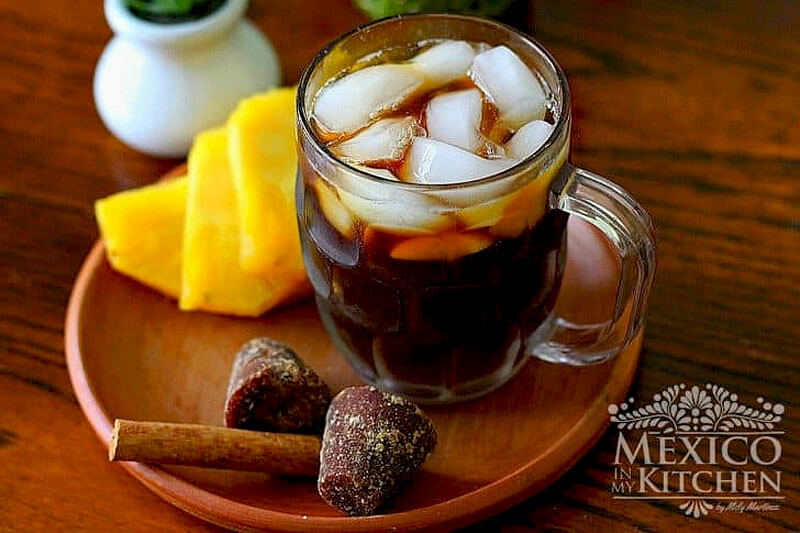

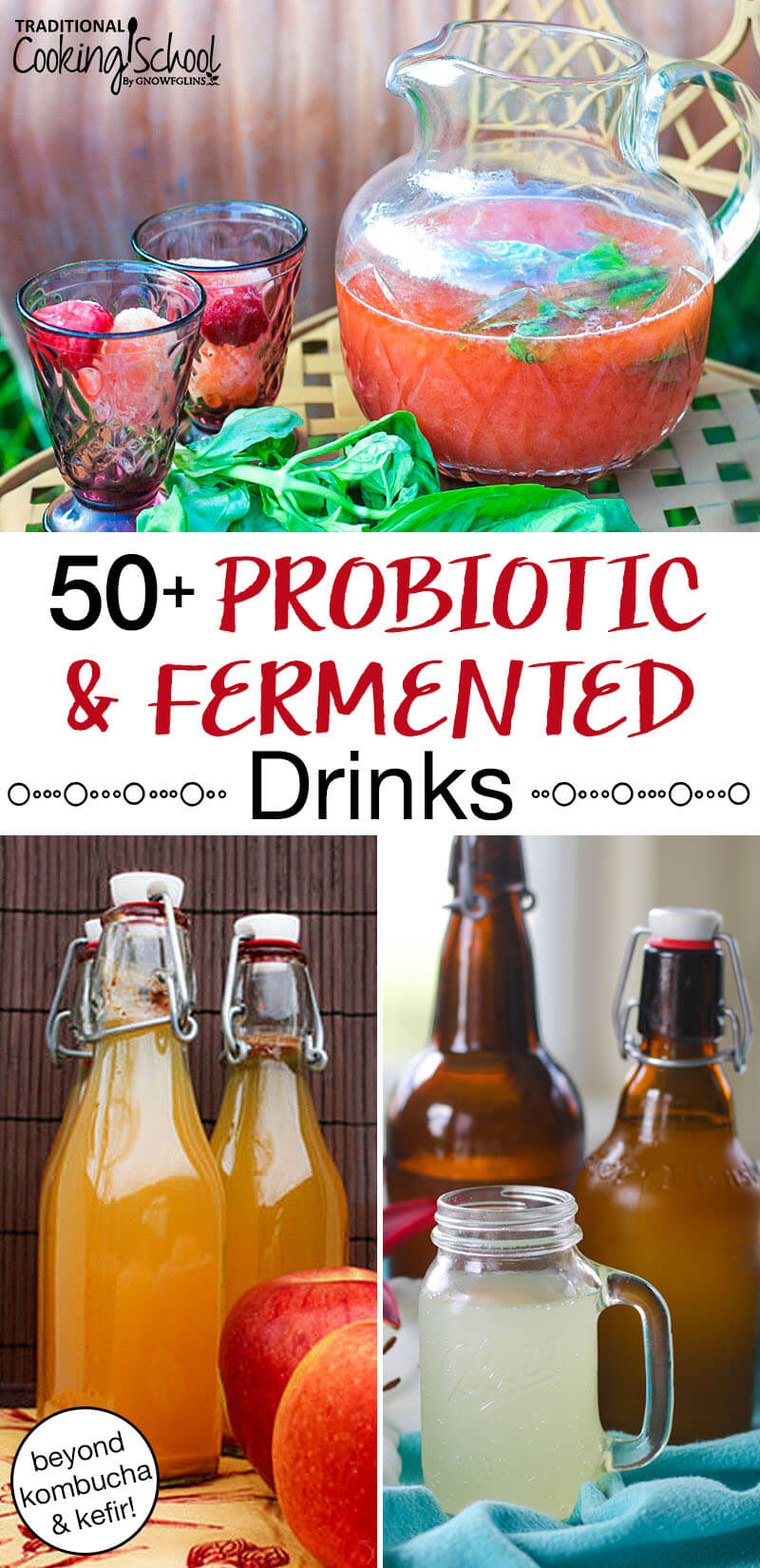
This question is for you Lindsey and Wardee as well. I have been making kombucha for a year or so but am wondering if it is good for my gut as I do not have a large intestine and my understanding is that most of the yeasts and bacteria live and are needed in the large intestine. I used to have leaky gut but have stopped eating grains and legumes and my digestion is better, bloating and gas is gone. Bottom line–is there a need for yeasts and bacterias in the small intestine?
This list looks awesome! I was wondering if these drinks are ok while pregnant? I saw a few that I would probably avoid (i.e. mead), but I would love to add some of these fermented drinks to my diet.
Thank you for such an awesome list! I’ve been wanting to add variety to my probiotics, and this will definitely help break the monotony.
Are these 56 recipies all together in a book or something? I want to collect them all but if I don´t have to copy and paste 56 times I´m glad! 🙂
I wonder how to pronounce some of these names of these foods.
If you go to dictionary dot com, you can type the word in the “definition” search box. When the definition shows up, above it you will see the word you typed, and to the right of the word you will see a speaker icon. Click on that, and you will hear the word pronounced.
I am extremely sensitive to whey & cannot consume it. Are there alternatives that I could use in place of whey in these recipes?
Hi Sally,
Not sure if you ever found an answer to your question. I believe there are different starters you can use for fermenting. I have only used whey myself but I understand some of these recipes are fermented using the natural bacteria and yeast present on the vegetables/fruit and wouldn’t require anything else to be added. Other starters include ginger bug, water kefir, ginger beer plant and vegetable starter culture. I hope you find something that works for you!
You can replace whey with water kefir. I do that all the time.
Wow, that is a huge list Lindsey! With this list, I tried the fermented coconut water, kefir- both water and milk, and the apple cider. Just want to ask, if you were to choose one of the probiotic drinks above, which do you think is the three healthiest drinks? Thanks
Probiotics or beneficial bacteria are great for improving digestive health, plus they could do a whole lot more. When it comes to choosing probiotic supplements, however, do you know what their most important ingredients are?
This is such a great list of probiotic drinks. I can’t wait to try some of these out over summer! Most drinks usually align with kombucha and kefir, I totally see that! So I think its great to have a resource that outlines the other great things that can be made that arn’t one of those two categories. Thank you for sharing this list!
Oh, do these recipes sound good. Unfortunately, the one I clicked on gave me a dead page. Please, could you check this out? Kindly put a rush the recipe!
Wow, What a variety of goodies! I’ve been doing kombucha and water kefir for almost a year now. I absolutely love them! My problem here is which one do I try first? Thank you sooo much for sharing!
Part of the secret to a healthy body is to eat probiotic foods and let the food fight it out inside.
Many people wonder if probiotic pills or powders provide the same benefit as probiotic foods since they seem to be marketed in the same way—healthy bacteria for our guts. However, probiotic foods work significantly better because of their construction.
To get into the small intestine and colon, where they do the work of breaking down and processing food and powering up the immune system, the bacteria first have to move through the stomach, but the stomach is filled with acid designed to kill bacteria. When you eat a probiotic food, the food itself provides a protective armor that helps shield the friendly bacteria. It also speeds the transport out of the stomach, thus keeping the good bacteria intact. Probiotic pills are often trapped in the acids of the stomach, and the probiotics are killed before the body ever gets a chance to use them. So consuming probiotic foods, such as kefir, kombucha, and cultured vegetables, is 100 TIMES more effective than taking pills.
Fermented vegetables stronger than supplements
Dr. Mercola, from Mercola dot com, stated, “Fermented foods not only give you a wider variety of beneficial bacteria, they also give you far more of them, so it’s a much more cost-effective alternative. Here’s a case in point: It’s unusual to find a probiotic supplement containing more than 10 billion colony-forming units. But when my team actually tested fermented vegetables produced by probiotic starter cultures, they had 10 trillion colony-forming units of bacteria.
Literally, one serving of vegetables was equal to an entire bottle of a high potency probiotic! So clearly, you’re far better off using fermented foods.””
Cultured foods are inexpensive, and the logical way the body wants to receive these beneficial bugs. Supplemental probiotcis do not colonize the digestive flora anyhow, you must take them for life and when you stop all benefit stops. Food sourced probiotics still cannot colonize the guts either.
Some clean up protein waste, others carbohydrate waste, others dairy, others raise or lower ph levels so others can survive, some kill yeast, and others help us digest our food so we can get the nutritional benefits from it, etc. Some bacteria’s only job is to help other bacteria perform their job whatever that may be. They are a colony, they live together much like people live together in a city, each performing a separate task or job so that community can survive and flourish.
We cannot possibly duplicate this in a pill or a powder.
There are some 500-1000 different microbials which inhabit and reproduce in the gut. THEY THINK>>>we know so little yet
Some are only there transiently and therefore, to have a “healthy” gut (based upon our historical traditional cultures), we need to consume beneficial microbials regularly. Whole food probiotics more effectively remain viable until they reach the large intestine.
*Homemade milk kefir has 56+ different beneficial microbials strains.
*Water kefir has about 30 different beneficial microbial strains.
*Commercial store-bought kefir has about 10 different beneficial microbial strains, more than most bottle probiotics.
*Kefir “starters” have about 7 microbial strains.
*Commercial yogurt has about 7 different beneficial microbial strains. (They add strains intentionally for benefit. Bifidum is one to look for, if you purchase commercial whole food probiotics.)
*Homemade yogurt strains vary, but each starter has somewhat limited different strains, usually about 5-7 different strains. Having different sources of microbials in our food is optimal.
Basically, most probiotics are not viable all the way to the gut, due to heat destruction during transportation and storage, acidity in the stomach, and low viability of powders and capsules. Commercial yogurts must have “Active Live Cultures”.
I prefer whole foods which are naturally cultured or fermented: kefir or yogurt from cow, goat, coconut, almond, hemp seed milk, etc. And fermented foods. Bubbies brand sauerkraut and dill pickles are easy to add to the diet.
“Homemade yogurt that is fermented for 24 hours, will have an average concentration of 3 billion cfu/mL of yogurt. If you were to eat a small bowl (500 ml) of 24 hour fermented homemade yogurt, you would receive 1.5 trillion beneficial bacteria –
100 times more bacteria than a 15 billion capsules. 15,000,000,000..amazing isnt it?
And homemade kefir has 5x that; homemade kimchi 10x that!
Dairy-free kefir, or any type of dairy could be made into kefir. And the kefir grains reproduce
Hi, I couldn’t help but notice in the picture of the keifer you were using a metal strainer… The metal kills the keifer grains so it’s best to only use plastic or wood when straining your keifer and only storing the keifer in glass containers.
This is great list! There are so many options for getting pro-biotics in!
Thanks for sharing! How long do fermented beverages keep?
Wow thats an impressive collection. Ive been lately collecting fermented drinks like kanjii and kvass, and you have got all of them in one list.
Maybe one is missing: Kvass made from old bread, a recipe from the eastern parts of Europe.
You say you help christian families, what about Jewish or Muslim or Buddhist families ???
Interesting to know. I am not a fan of Komucha, but maybe I would enjoy some of the others.